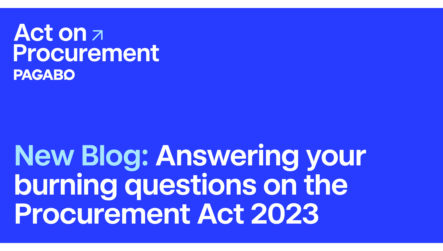Essential Guide to the Procurement Act 2023 and Procurement Regulations 2024

Essential Guide to the Procurement Act 2023 and Procurement Regulations 2024
The new Procurement Act 2023 is a procurement regime scheduled for introduction in response to Brexit. It combines four existing regimes into one piece of legislation. It’s designed to make public sector procurement simpler, more flexible and more transparent, and comes into force on the 24th of February 2025.
These regulations are usually updated around every decade. The Procurement Act actually combines four previous regulations – the Public Contract Regulations 2015, Utilities Contracts Regulations 2016, Concessions Contracts Regulations 2016 and Defence and Security Public Contracts Regulations 2011. It’s transferring references from EU law as a result of Brexit.
The new procurement regulations introduce some significant changes to public contract regulations in the UK. If you’re a Contracting Authority, an agent of a Contracting Authority, or your business either supplies or would like to supply public sector bodies, you need to understand the changes in the new legislation and how they will affect you.
That’s why we’ve created this in-depth public Procurement Act 2023 summary, covering the new procurement regulations introduced in 2024. If you would like to speak with one of our procurement experts, get in touch.
What are the objectives of the Procurement Act 2023?
To get a better grasp of the changes in the Act, first it’s helpful to understand why the government are introducing it and what they hope to achieve.
The Act is designed to transform public procurement to create a fairer procurement process. Procurement will be open to as many businesses as possible, and provide Contracting Authorities with the best works, goods and services.
There are a few specific objectives that feed into this.
Simpler and more flexible
Several of the changes being introduced in the Act are intended to make public sector procurement easier to understand and more flexible in use, to encourage participation from the supplier market. Many regulations are consolidated, and new flexible procedures are introduced. The new regulations will meet the UK’s procurement needs while remaining compliant with our international obligations.
Open to more entrants
One of the biggest barriers with the old procurement system is that it’s difficult for small and medium-sized businesses to compete for public contracts. The 2024 procurement regulations will open up public procurement to smaller businesses and social enterprises so they can compete on a level playing field for public contracts.
Tougher action on underperformers
Under the old regime, the regulations govern the procurement process. Under the Procurement Act 2023, there will be a shift in focus to the full procurement and contract lifecycle. The new regime will grant Contracting Authorities new powers to exclude any suppliers who pose unacceptable risks .
The exclusion of suppliers by the government is not a new concept but the Act will expand the existing rules and add a clearly defined process.
Increased transparency
The Act introduces increased transparency through the lifecycle of contracts. This allows the spending of taxpayers’ money to be properly scrutinised and allows authorities to monitor supplier performance and compliance more efficiently.
What are the main changes in the Procurement Act 2023?
So, we know what the Act aims to achieve. Let’s have a look at the specific changes the government have introduced to reach those goals.
Simplification of the procurement process
One of the core principles of the Act is the simplification of the procurement process. This will streamline the way Contracting Authorities procure the supplies, works or services they need. It will streamline the routes to market and make it easier for smaller businesses to compete for contracts.
It will do this in several ways.
Use of a centralised digitalised platform
The Procurement Act 2023 will introduce a central digital platform for both suppliers and Contracting Authorities. This means that everything will be in one place and easily accessible, simplifying the whole process. A unique identifier will be assigned to each procurement, supplier and Contracting Authority. This will link all data associated with each procurement including relevant notices and KPI data.
The central digital platform also aims to reduce duplication when bidding for opportunities by allowing supplier information to be stored.
And it will improve transparency, as all the data will be available to view.
Reduction in the number of procedures
The Act will combine over 350 procurement regulations into a single unified regime. This will reduce complexity, increase understanding of provisions and encourage participation.
The Act will also streamline the procedures under the current regime from seven to two competitive procedures. These are the old open procedure, and the new competitive flexible procedure. The new mechanism aims to create maximum flexibility for procurement solutions and reduce barriers to entry.
Increased focus on innovation and sustainability
Another important change in the Act is the increased focus on innovation and sustainability.
More provision for innovative partnerships
Innovation across the public sector is seen as key to driving positive change. So, the new Act will let Contracting Authorities choose creative new solutions to fit their needs.
More weight on environmental and social factors
Under the old regulations, decisions were made purely on the basis of cost and value The new Act means Contracting Authorities will be able to place more value on environmental and social factors.
MEAT becomes MAT
The flexibility to consider alternative criteria to cost is available in the old regime. But the Procurement Act will introduce new terminology that means Contracting Authorities can base their decisions on MAT (Most Advantageous Tender) rather than MEAT (Most Advantageous Economical Tender). This will increase the emphasis on factors other than cost and encourage forward-looking decisions.
An emphasis on ethical procurement
The Act will emphasise value for money, public benefit and integrity. Procurement departments will need to revise their processes to align with the updated principles. They’ll also need to take into account the ethical standards of suppliers.
Supplier management and qualification will be key to delivering ethical procurement.
Exclusion and debarment
Discretionary and mandatory exclusion grounds will remain very similar, targeting non-compliance and poor performance. But the scope will be wider under the new Act.
The changes in the Act are centred around transparency. There are plans to launch a debarment register housed on a central digital platform, and the mandatory issue of a new notice detailing any unsatisfactory performance or contract breaches. Contracting Authorities will need to review and verify applications against the live debarment register and any unsatisfactory performance notices for each procurement opportunity.
Social value
The Procurement Act 2023 will introduce several changes to ensure social value is a key element in procurement . Contracting Authorities will be able to evaluate the social value suppliers bring as part of their decision-making process.
Promotion of fair labour practices
Suppliers will be encouraged to demonstrate a commitment to fair labour standards. The Act will also require that suppliers involved in modern slavery are excluded from the procurement process.
Prompt payment provisions
To help make public procurement accessible to smaller businesses the Act will introduce a mandatory 30-day payment term. This requirement will affect the whole supply chain, so subcontractors also benefit.
Under the new regime, Contracting Authorities will have to use 30-day payment terms in new contracts. This must also be passed down their supply chain.
The government will also aim to pay 90% of undisputed and valid SME invoices within five days. All undisputed and valid invoices should be settled within 30 days.
Promotion of SME participation
The Procurement Act 2023 will shift how Contracting Authorities are encouraged to engage with SMEs in regulated procurements, and how they provide opportunities to win public contracts. It aims to level the playing field and provide opportunities for businesses of all sizes to compete and win public contracts.
Contracting Authorities will have a duty to assess potential barriers SMEs face throughout the procurement lifecycle, and to consider what can be done to remove or reduce these.
Support for SMEs
There will be several support provisions for SMEs. These include an increased transparency agenda, to allow SMEs to better plan their resources for public procurement. There will also be further enhancement and supporting notices associated with pre-market engagement. This will allow Contracting Authorities to test procurement hypotheses with the SME market and further understand the barriers that SMEs face and should allow for an appropriate procurement strategy to be built.
The Cabinet Office has also created a series of knowledge drops specifically targeted at SMEs, as well as a comprehensive portfolio of guidance documents.
Simplified procurement procedure
The Act aims to simplify and streamline the procedures and remove complexities to make it easier for SMEs to bid. Standardised and accessible procedures will make it simpler to place bids across different public sector organisations.
Larger contracts broken into smaller packages of work
Contracting Authorities will be encouraged to consider how to support SMEs, for example by breaking large projects into smaller lots. This will allow specialist SMEs the opportunity to bid directly.
Strengthened contract and performance management
The Procurement Act 2023 will introduce changes to help ensure contracts are delivered effectively, efficiently and as promised. It also aims to make suppliers and Contracting Authorities more accountable. This will be supported by several new notices throughout the Contract term.
Clearer contract management obligations
Contracting Authorities should develop detailed and proportionate contract management plans for contracts. These will outline how the contract is managed throughout its lifecycle, the frequency of data inputs and impacts of underperformance.
Supplier performance
Public contracts valued over £5 million will require Contracting Authorities to set and publish a minimum of three key performance indicators. They must then publish an assessment of supplier performance at least once every twelve months and on termination of the contract. This is the first time that KPIs have been legislated for in UK public procurement legislation.
In addition, where poor performance has been established, a contracting authority must again publish a Contract Performance Notice.
Increased flexibility in procurement
More flexibility will allow Contracting Authorities to adapt better to changing needs, encourage innovation, and tailor procurement strategies to projects. The aim is to allow Contracting Authorities to create a more dynamic procurement process, aligned to the project and its market.
Allows Contracting Authorities to design procurement procedures
The Act will introduce a competitive flexible procedure. This will allow Contracting Authorities the freedom to design their own procedures. They can incorporate various processes into the procedure, such as negotiation, dialogue or a demonstration stage.
Key terminology
The objective to create a simpler system will be supported by changes in terminology. The Act will introduce several new concepts with new terminology, and it will also introduce some new terminology for concepts we are already familiar with. Some language will remain the same, or similar. The aim is to move away from EU language and terminology.
More permissive language
While some of the language is familiar in the Act, it is more relaxed than before. The use of more permissive language is intended to allow Contracting Authorities more flexibility and discretion when making decisions.
Contracting Authorities
According to the official guidance, “Contracting authority’ is the term used to refer to an entity (referred to as a ‘person’ in the Procurement Act 2023 (Act) to ensure it applies to a variety of circumstances) that is subject to the Act. A legal definition of Contracting Authorities is therefore essential in order for entities to determine whether they are in scope of the rules, or not.”
The term ‘Contracting Authority’ is reinforced and more precisely defined in the Act. The Act covers public contracts entered into by contracting authorities with a value above the relevant threshold.
Some terminology changes
Changes to the language of the Act are more than simply changing a few key terms.
There are some important changes to be aware of.
Agent – The term ‘agent’ has been introduced which adds clarity to the role that organisations like Pagabo occupy, compliantly setting up and administering frameworks on behalf of a named Contracting Authority(ies).
Below threshold tender notice – A mandated Notice used to publish details for below-threshold procurements is now required to be published centrally in a single place and provides easier and greater visibility.
Conflicts assessments – Contracting authorities are to formally prepare a conflicts assessment and to publicly confirm that this has been done and that it has been reviewed and revised as necessary. The Act formalises these processes to provide greater transparency supported by record-keeping.
Convertible contract – This is a contract which is not currently a public contact but will, if modified, become a public contract
Contract Termination Notice definition – Mandatory transparency requirement whenever a contract comes to an end, including following termination under one of the implied termination grounds via the issue of a Notice.
Pipeline notice – A notice setting out specified information about any public contract with an estimated value of more than £2 million
Planned Procurement Notice and Preliminary market engagement Notice – Prior Information Notice (PIN) has changed to a Planned Procurement Notice and Preliminary market engagement Notice. These two new Notices will broadly serve the same function as the previous PIN
Assessment summaries – Standstill Letters has changed to Assessment summaries which will broadly serve the same function
Updated procurement routes for simplicity and flexibility
The Procurement Act 2023 will introduce some significant changes to procurement frameworks. These are to simplify the procurement process and increase flexibility for Contracting Authorities.
Open frameworks
Open frameworks will be extended from four to up to eight years. They’re dynamic and allow new suppliers to join at specified intervals. This means the framework is flexible and allows Authorities to bring in new suppliers as circumstances change.
Closed frameworks
Closed frameworks are more restrictive. Suppliers are chosen at the beginning, and no new ones are allowed in for the duration. The Act will allow greater flexibility in the duration of closed frameworks than before. They can be extended beyond the four-year limit if justified by the nature of the project.
Dynamic markets
Dynamic markets are a more flexible replacement for Dynamic Purchasing Systems (DPS). DPS was mainly used for ‘off the shelf’ procurement, but dynamic markets will allow for broader and more flexible use. They will remain open for the duration of the contract, which means that new suppliers can join at any time.
Standstill process updated
The standstill period is the period between the Contracting Authority announcing its intention to enter into a contract and the contract commencing. The standstill period provides an opportunity for suppliers to raise any concerns about, or formally challenge, the award decision before the contract is entered into.
Under PCR15, the standstill period runs for a minimum of 10 calendar days and has no direct link to the publication of a formal notice. Under PA23, the standstill period will run for a minimum of 8 working days and be triggered by the release of a contract award notice on the central digital platform
A significant change is that the contract award notice that triggers the start of standstill must include information about ‘assessed tenders’ and, in the case of contracts over £5 million, the unsuccessful suppliers who submitted those tenders.
Ensures fairness
The standstill period will allow all bidders to review the decision and raise any concerns or challenges they may have. If a challenge is raised, the standstill period may be extended.
Enhances transparency
As part of the standstill process, all bidders must be provided with a compliant award decision notice. This includes details like the reasons for the award and the characteristics of the winning bid. It lets unsuccessful bidders assess whether they were treated fairly and in accordance with the rules.
Increased accountability
If a complaint is lodged, contract signing can be delayed until the challenge has been investigated. This encourages Contracting Authorities to be open and compliant with regulations to avoid potential challenges.
Who do the changes apply to?
The Procurement Act 2023 will introduce changes that affect both suppliers and Contracting Authorities. It will also make it easier for smaller businesses to bid for contracts.
Contracting Authorities can expect increased flexibility when designing procurement contracts. Suppliers, especially small and medium-sized ones, should benefit from greater access to procurement opportunities.
How should I prepare for the procurement reform changes?
Preparation is key both for Contracting Authorities and for suppliers. They’ll need to adapt their workflows to new procedures, make sure they’re compliant with the new regulations and ensure they’re maximising the opportunities under the new rules.
Here are a few points that Contracting Authorities and suppliers should consider.
Key steps for Contracting Authorities
If you’re involved in procurement at a Contracting Authority (a term which now includes any public sector organisation procuring goods or services) you’ll need to make sure your organisation is compliant with the new regulations. You’ll also need to ensure you get the best value under the new rules.
Review and update procurement policies and procedures
It’s important that all of your policies align with the regulations in the Act. So, you’ll need to review each one against the Act and update them where necessary. You’ll need to do the same with any procurement procedures your organisation has in place.
Training and education
You need to understand the changes to the Act in fine detail. The Cabinet Office has produced a series of Procurement Act 2023 guidance documents which cover the changes in some detail, and there are professional workshops available. Companies like Pagabo offer free webinars, too.
Once you have an understanding of the Procurement Act 2023, you’ll need to make sure it filters down to everyone else involved in procurement in your organisation.
Engage with suppliers
If you want a seamless transition to the new rules, you’ll need to keep your suppliers up-to-date. That means making sure that they understand the changes in the Procurement Act 2023 but also how you plan to implement those changes.
You could consider organising training forums to pass information to suppliers and to help facilitate networking. You must also make sure that all your processes and changes are well documented, and suppliers are kept well informed.
Assess pipelines
There will be a crossover period between the new rules and the old, as projects started under the old regulations continue and complete after the Act has been introduced.
You need detailed plans to understand which projects will fall under which set of regulations, and make sure everything is compliant with the correct rules.
Introduce new terminology early
The Procurement Act 2023 introduces new terminology and language. The sooner you start using the new language, the sooner it will filter down through your organisation and become commonplace.
This will help make sure you have a smooth transition to the new rules. It will also enhance compliance and understanding throughout your organisation, and encourage adoption of the changes in the new Act.
Make sure you’re using the right frameworks for your organisation
Chances are, the frameworks you’re currently using will need changing to take into account the changes. So you’ll need to analyse your current and planned projects, and match them up with the appropriate frameworks.
Pagabo can provide access to frameworks established by Contracting Authorities that will continue under the old regulations until they expire, and then help you switch over to the new regulations.
Risk management and mitigation
With any change comes the introduction of new potential risks. You need to conduct in-depth risk assessments to be sure that you understand the risks posed by the new Act, and that your organisation is protected against them.
You’ll need to keep detailed and up-to-date risk registers, and keep on top of risk management with regular risk audits.
Invest in digital procurement systems
The new Act has a focus on centralised digital procurement, but there are benefits to using digital systems beyond compliance. Digital procurement procedures increase transparency and can make the procurement process quicker and simpler.
If you can, research and introduce compliant systems as soon as possible. This will ease the transition to the new regulations.
Key steps for suppliers
It’s just as important for suppliers to be prepared for the Procurement Act 2023. As the regulations change, the processes you have to navigate to successfully bid for projects will alter too. And while the new Act is intended to make the public procurement process simpler, you still need to be aware of the changes and how they will affect you.
Familiarisation with the new rules
Make sure you understand the key changes in the Act. Consider how they will affect you and your relationship with the Contracting Authorities you work with.
The new Act has a focus on transparency and accountability. Learn how these changes appear in the Act, but also how they will be applied by Contracting Authorities. Then, make sure your business and bids are fully compliant with the new regulations.
Training and education
There are a lot of changes to understand in the new Act. So, take advantage of any training sessions available to you. Make sure you involve employees at all levels of your business.
Local Contracting Authorities may run workshops for suppliers. The Government has produced a series of Procurement Act 2023 guidance documents. And companies like Pagabo offer free webinars, hosted by experts to help you get ahead of the changes.
Develop and strengthen relationships with Contracting Authorities
Staying in touch with clients is a vital step. It will give you a better understanding of how they build new regulations into their procurement processes.
It will also help you be sure that your processes work well with those of the Contracting Authorities you want to work with.
Stay informed about opportunities
With the new, centralised digital platform, the way procurement opportunities are advertised and shared will change.
To give your business the best chance of knowing what opportunities are available, make sure you’re on all the appropriate platforms. Be sure to make the most of any networking opportunities, with clients or other suppliers, too.
Make sure bids are competitive under the new regulations
The shift from MEAT to MAT changes how Contracting Authorities decide on winning bids. It also allows suppliers to focus on elements beyond just cost.
The key to winning bids under the new Act is likely to be social value. So, when building your bids, make sure you demonstrate how social value is delivered through your plan.
Understand and plan for the changes in risk in the new regulations
You need to understand the risks to you and your business posed by the changes in regulations in the new Act. You’ll need to understand how the changes apply to you and your area, and conduct risk assessments and audits.
It’s also worth exploring the change in risk to Contracting Authorities, and building in safeguards to your bids.
Conclusion
The changes introduced in the Procurement Act 2023 are significant. The way Contracting Authorities conduct their procurement will be very different under the new regulations.
The changes have several aims:
- To make the procurement process simpler, quicker and fairer
- To make public sector procurement more ethical and sustainable
- To open up public sector procurement to more SMEs
- To make procurement more transparent
These changes are major. There’s a lot for Contracting Authorities and suppliers to take in, and a lot of changes they need to make.
If you’re struggling to make sense of the new regulations, or you need advice on the best frameworks for your organisation, Pagabo can help.
We can advise you on the changes your organisation needs to make to stay compliant with the new regulations, and we can provide the frameworks you need to be able to procure efficiently.
If you’d like a chat about your organisation’s procurement needs, get in touch.
Discover our frameworks














































































































